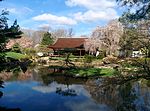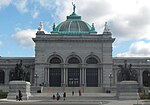44th and Parkside Ballpark
1903 establishments in Pennsylvania1950s disestablishments in PennsylvaniaAmerican football venues in PennsylvaniaBaseball venues in PennsylvaniaDefunct American football venues in the United States ... and 9 more
Defunct baseball venues in the United StatesDefunct sports venues in PhiladelphiaDemolished buildings and structures in PennsylvaniaDemolished sports venues in PennsylvaniaNegro league baseball venuesPennsylvania state historical marker significationsSports venues completed in 1903West PhiladelphiaYMCA buildings in the United States
The P.R.R. YMCA Athletic Field, also known as Penmar Park and commonly referred to in the 1930s and 1940s as the 44th and Parkside ballpark, was an athletic field and ballpark in West Philadelphia from 1903 to the early 1950s. It was built by the Pennsylvania Railroad YMCA for use by its employees. Behind the right-field fence stood the roundhouse of the main yard of the Pennsylvania Railroad. The Negro league baseball Philadelphia Stars played home games at the park from 1936 until 1952.
Excerpt from the Wikipedia article 44th and Parkside Ballpark (License: CC BY-SA 3.0, Authors).44th and Parkside Ballpark
Belmont Avenue, Philadelphia
Geographical coordinates (GPS) Address Nearby Places Show on map
Geographical coordinates (GPS)
| Latitude | Longitude |
|---|---|
| N 39.9775 ° | E -75.2138 ° |
Address
Discovery Charter School
Belmont Avenue
19131 Philadelphia
Pennsylvania, United States
Open on Google Maps











